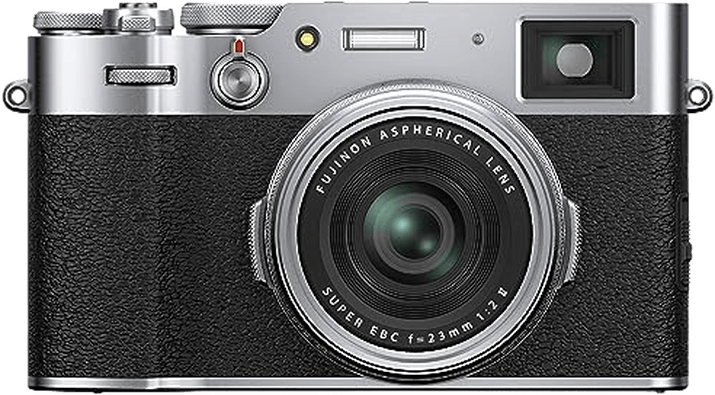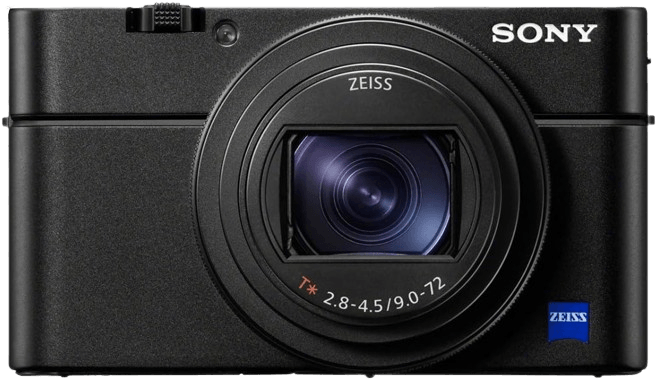Fujifilm X100V vs Sony Cyber-shot DSC-RX100 VII Comparison
Fujifilm X100V

Sony RX100 VII

The Fujifilm X100V takes the lead with a score of 69/100, while the Sony Cyber-shot DSC-RX100 VII trails behind at 60/100. Both cameras share similarities as they were released close to each other, in 2020 and 2019 respectively, and have a similar launch price range ($1399 for Fujifilm and $1200 for Sony).
The Fujifilm X100V excels with its mirrorless camera type and larger size (128 x 75 x 53mm), providing a more professional feel and better handling. Its weight of 478g also contributes to its sturdiness.
On the other hand, the Sony Cyber-shot DSC-RX100 VII is a compact camera, which makes it more portable and travel-friendly. Its smaller size (102 x 58 x 43mm) and lighter weight (302g) make it ideal for casual photographers.
To sum up, the Fujifilm X100V is a better choice for those seeking a professional and sturdy camera, while the Sony Cyber-shot DSC-RX100 VII is perfect for casual photographers who value portability.
Fujifilm X100V vs Sony Cyber-shot DSC-RX100 VII Overview and Optics
The Fujifilm X100V wins in the optics comparison with a score of 66/100, while the Sony Cyber-shot DSC-RX100 VII scores 61/100. Both cameras share some common specifications, such as having a CMOS sensor, fixed lens mount, and no option to change the lens. However, there are notable differences that set them apart, giving the edge to the Fujifilm X100V.
The Fujifilm X100V boasts a higher megapixel count at 26 compared to the Sony’s 20 megapixels. This results in better image quality and detail. Moreover, the X100V has a faster shooting speed of 11 frames per second, which is more than double the RX100 VII’s 5 frames per second. This allows for capturing fast-moving subjects more efficiently. Additionally, the X100V has a larger APS-C sensor, which contributes to improved low-light performance and dynamic range.
On the other hand, the Sony Cyber-shot DSC-RX100 VII has its advantages. It features image stabilization, which the Fujifilm X100V lacks. This can help reduce the effects of camera shake, leading to sharper images in certain situations. Furthermore, the RX100 VII has a DXOMARK score of 63 for its sensor, providing an objective measure of its performance, while the X100V does not have a DXOMARK score.
Taking these points into account, the Fujifilm X100V outperforms the Sony Cyber-shot DSC-RX100 VII in terms of image quality, shooting speed, and sensor size. However, the Sony offers image stabilization, which can be beneficial in specific scenarios. Ultimately, the choice between these two cameras will depend on the individual’s priorities and preferences.
Fujifilm X100V vs Sony Cyber-shot DSC-RX100 VII Video Performance
The Fujifilm X100V and the Sony Cyber-shot DSC-RX100 VII both have a video score of 91/100, showcasing their exceptional video capabilities. These cameras share several video specifications, including 4K max video resolution, 120fps max video frame rate, and built-in time-lapse functionality.
Despite having the same score, the Fujifilm X100V has an edge over the Sony Cyber-shot DSC-RX100 VII in terms of max video dimensions. The X100V offers 4096 x 2160 max video dimensions, which is higher than the RX100 VII’s 3840 x 2160. This difference means that the X100V can produce videos with a slightly wider aspect ratio and more detail, providing more cinematic results.
On the other hand, the Sony Cyber-shot DSC-RX100 VII does not have any distinct advantages over the Fujifilm X100V in terms of video performance. Both cameras offer the same frame rate and time-lapse functionality, making them equally suitable for capturing fast-paced action and creating stunning time-lapse videos.
Given the equal video scores and similarities in specifications, both the Fujifilm X100V and the Sony Cyber-shot DSC-RX100 VII are excellent choices for those looking for high-quality video performance in a compact camera. However, the Fujifilm X100V’s slightly higher max video dimensions make it a better choice for those seeking a more cinematic look in their videos.
Fujifilm X100V vs Sony Cyber-shot DSC-RX100 VII Features and Benefits
The Fujifilm X100V outperforms the Sony Cyber-shot DSC-RX100 VII in features with a score of 85/100 compared to 68/100. Both cameras share several specifications, including a 3-inch screen size, touchscreen capabilities, flip screen, GPS absence, WIFI, and Bluetooth connectivity.
The X100V excels with its higher screen resolution of 1,620,000 dots, offering better image clarity and detail than the RX100 VII’s 921,000 dots. This significant difference in screen resolution contributes to the X100V’s superior feature score and overall performance.
Although the RX100 VII falls short in screen resolution, it matches the X100V in several essential aspects, such as touchscreen functionality, flip screen, and wireless connectivity options. These shared features ensure both cameras provide a satisfactory user experience, despite the RX100 VII’s lower feature score.
Considering the differences and similarities in features, it is evident that the Fujifilm X100V stands out as the better option due to its higher screen resolution. This advantage makes it easier for users to review images with greater clarity and precision. Nevertheless, the Sony Cyber-shot DSC-RX100 VII remains a viable choice for those seeking a camera with comparable features to the X100V but at a potentially lower price point.
In comparing the Fujifilm X100V and Sony Cyber-shot DSC-RX100 VII, the X100V’s superior screen resolution makes it the preferable choice for users seeking the best possible image review experience on their camera’s display. Both cameras offer several essential features, but the X100V’s higher feature score confirms its edge over the RX100 VII in this aspect.
Fujifilm X100V vs Sony Cyber-shot DSC-RX100 VII Storage and Battery
The Fujifilm X100V outperforms the Sony Cyber-shot DSC-RX100 VII in storage and battery with a score of 37/100, compared to Sony’s 29/100. Both cameras have one memory card slot and accept SD, SDHC, and SDXC cards. Additionally, they both offer USB charging.
The Fujifilm X100V’s advantage lies in its battery life, providing 420 shots with its NP-W126S battery. Conversely, the Sony Cyber-shot DSC-RX100 VII only offers 260 shots using its NP-BX1 battery. However, the Sony camera has an edge in storage versatility, as it also supports Memory Stick Pro Duo cards.
In comparing the storage and battery aspects, the Fujifilm X100V is the clear winner due to its longer battery life, while the Sony Cyber-shot DSC-RX100 VII offers slightly more storage options.
Fujifilm X100V vs Sony Cyber-shot DSC-RX100 VII – Our Verdict
Are you still undecided about which camera is right for you? Have a look at these popular comparisons that feature the Fujifilm X100V or the Sony Cyber-shot DSC-RX100 VII:
